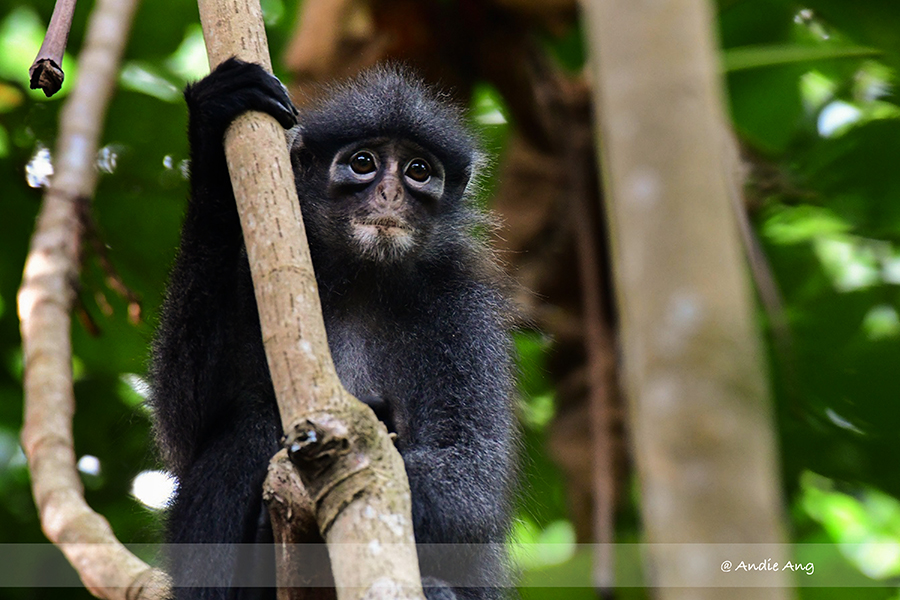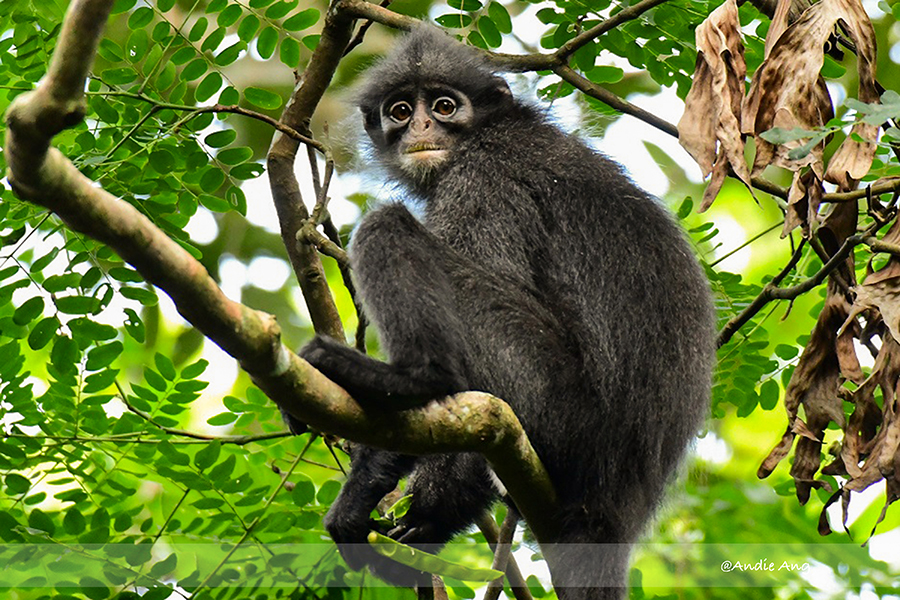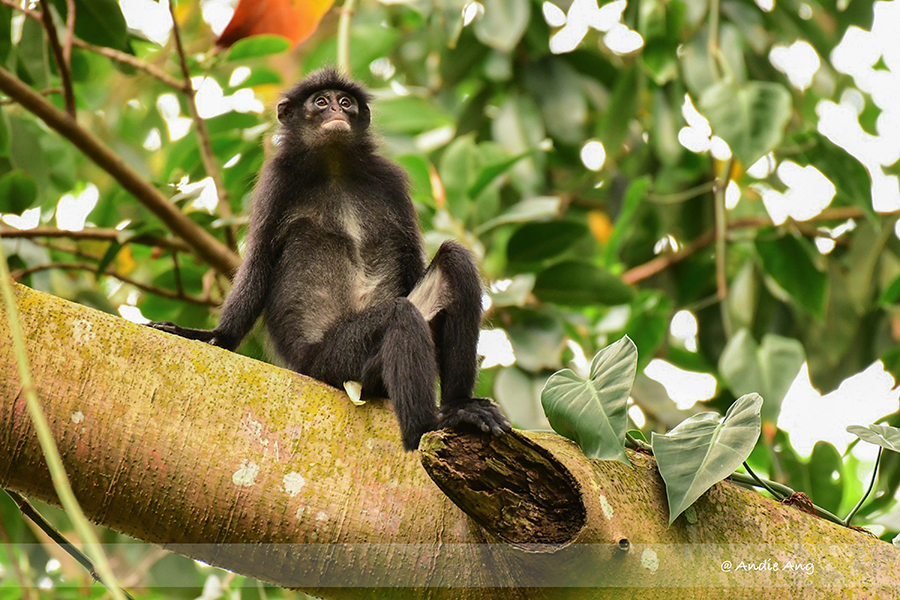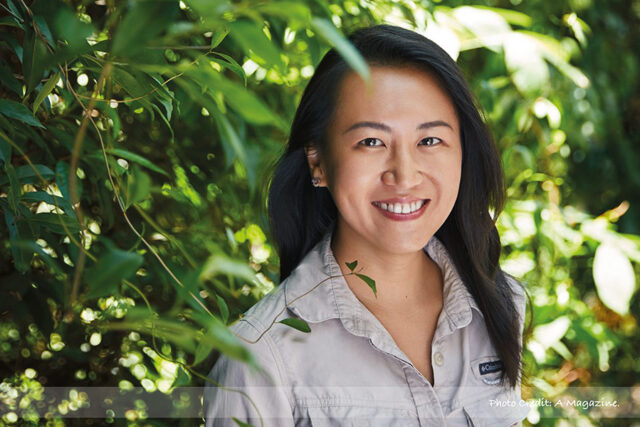I’ve been trying to photograph some unique and rare animals in Singapore. One of them is the Raffles’ banded langurs. I researched to find them. It brought me to Dr. Andie Ang.
She has been studying and paying attention to the Raffles’ banded langur ( Presbytis femoralis ), a critically endangered primate in Singapore.
Here is our nature talk with her.
Can you tell us your story with ‘Ah Boy’ that made you study more about primates?
When I was 10 years old, I was given a wild vervet monkey from Africa as a pet. The juvenile monkey was illegally taken by friends of relatives who were sailors to Africa. Not fully grasping the difference between a wild animal and a domestic pet at that time, I raised my pet monkey ‘Ah Boy’ like I would have to a pet dog; bringing him for a walk in the neighbourhood on my shoulders, feeding it with home-cooked food… Each day he climbed up my shoulders to groom my scalp, pulling apart my hair and meticulously carrying out a search, much like how the monkeys do in the wild, grooming each other for parasites and dirt particles.
Gradually over the next five years, as my pet monkey grew bigger, I learned through watching him every day that he was miserable chained up at home, without his rightful freedom to be in the forests and among his friends. It was after going through several contacts internationally and locally that I managed to contact Louis Ng from ACRES. We raised funds and through their help, my pet monkey was repatriated back to Zambia, Africa in 2004. The monkey is the inspiration of the ACRES logo and is my motivation to learn about monkeys and the threats they face so as to better help them.

Who actually really motivated and helped you to become a research scientist?
I count myself very lucky to have a number of people who have been encouraging. My family was initially concerned about the prospects of such work in Singapore and in the region. Still, they continue to be supportive because it is apparent to them throughout these years how I enjoy doing what I am doing. My friends were always curious about my work in the beginning, asking questions and trying to understand my passion. They were very encouraging and also let me know that they were able to appreciate wildlife and the environment a little better through our conversations, which was wonderful.
I am grateful to Prof. Rudolf Meier, who was my academic advisor during my undergraduate and Master’s studies at the National University of Singapore. He was the first person to encourage me to pursue a subject that I was interested in, and helped me throughout these years, providing advice and support. Wildlife Reserves Singapore has been financially supporting my research from the beginning, first through the Ah Meng Memorial Conservation Fund, and then the WRS Conservation Fund.
Prof. Tommy Koh is an advocate for nature conservation and is extremely supportive of student initiatives in local conservation efforts. He was the patron of my Master’s project on the Raffles’ banded langurs in 2007, and continues to be one for the current project.
I completed my Ph.D. through the University of Colorado Boulder under the guidance of Prof. Bert Covert. He made possible my research in Vietnam. There, my collaborators supported every step I took and generously welcomed me, which made me feel very much at home. Ultimately, it was my pet monkey, Ah Boy, who first sparked my interest in primates and wildlife conservation.
Any advice for your generation if they want to become a research scientist?
A research scientist can be working in different fields (not necessarily in wildlife research/conservation), depending on the area of interest. My advice is to first find and recognise your interest and passion, learn and gather knowledge in that field, and get into the network of people in that area to build connections and identify opportunities.

What is special about the Raffles’ banded langur?
The Raffles’ banded langur is a species of monkey that is only found in Singapore and southern Peninsular Malaysia. This monkey was first noted as a new species to science based on specimens from Singapore, which makes Singapore its type locality (location where it was first described). Sir Stamford Raffles was one of the first people to pen down notes describing the animal, hence the attribution to his name. The Raffles’ banded langur is only one of three species of non-human primates in Singapore, and the largest arboreal mammal here. However, it is critically endangered with only fewer than 70 individuals left in Singapore.
How do you collect their data and how can you identify them?
We carry out field observations and collect data on the plant species that they consume in the forests. We also collect their fecal samples whenever we come across them, and bring them back to the lab in NUS to do DNA analyses so as to find out more about their diet and genetic health. We also take photographs of the langurs so that we can identify certain physical characteristics in order to differentiate individuals. Since August 2016, we have citizen scientists who are surveying in the field as well, collecting data on the langurs, such as threats that might affect their survival. For instance, citizen scientists helped to identify a hotspot where the langurs crossed on the road in order to get from one forest fragment to the next. NParks later installed a rope bridge to facilitate the safe movement of the langurs and other arboreal animals to minimise the chances of them being struck by vehicles on the roads.

Any there others monkey species that exist in our forest besides the Raffles’ banded langur and long-tailed macaque?
There are three species of non-human primates that are native to Singapore: Sunda slow loris, long-tailed macaque, and Raffles’ banded langur. Since end-2019, there’s two dusky langurs (likely from Malaysia) in the midst.
https://www.straitstimes.com/singapore/environment/monkey-species-native-to-malaysia-spotted-here
What’s the best approach when we see wild animals such as monkeys?
When visiting nature areas or nature reserves, try not to bring food as the sight and smell of food will attract animals. Similarly, do not bring plastic bags, or keep them out of sight in backpacks as monkeys have learned to associate plastic bags with food. The monkeys have no interest in humans if not for food. When encountering wild animals like monkeys, maintain a safe distance of at least 3 metres and do not stare into their eyes. We can enjoy peaceful encounters with animals when we understand and follow the recommended behavioural etiquette.
Andie Ang, Ph.D.
Research Scientist with Mandai Nature, and President of Jane Goodall Institute (Singapore)














